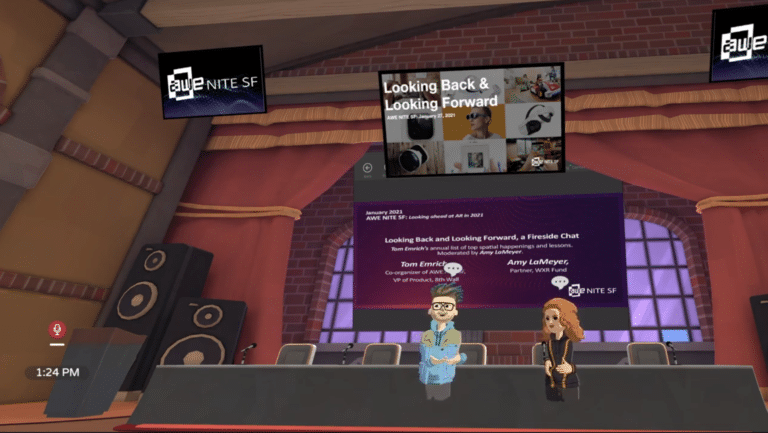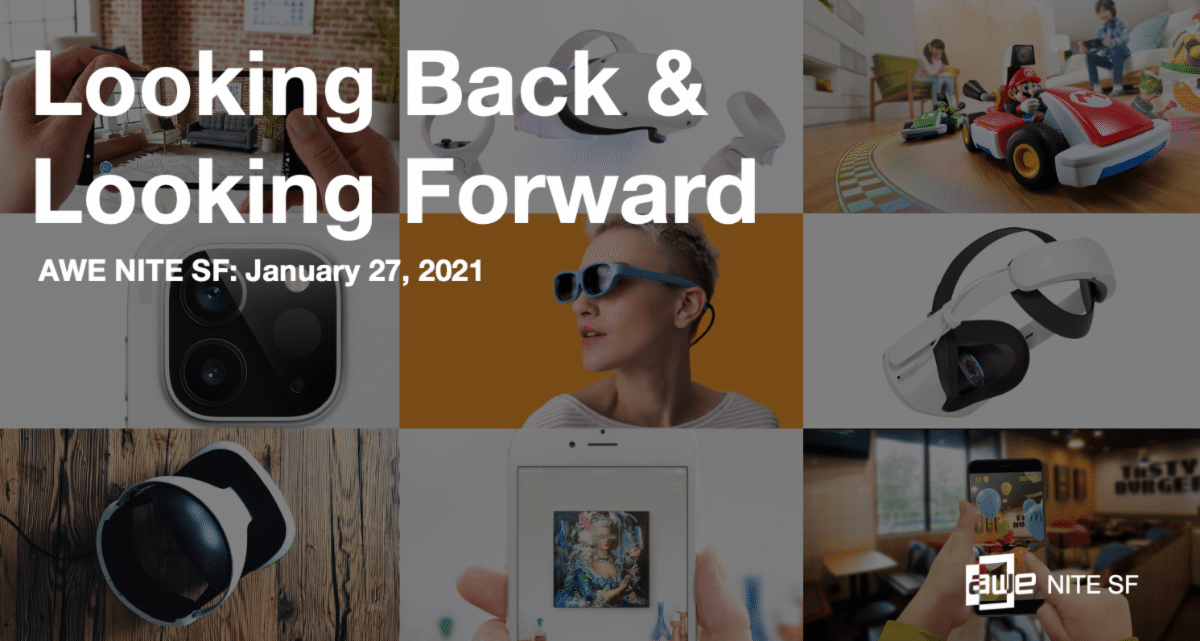
AR continues to hold ample potential… but it’s counterbalanced by the technology’s relatively low traction. Though it has reached meaningful adoption, it’s still in early-adopter phases. And it’s far from the revolutionary and ubiquitous technology that was trumpeted circa-2017.
So where are we in AR’s lifecycle and what will the coming year look like? This was the topic of a fireside chat hosted by AWE Nite SF* and fittingly held in Altspace VR. It featured 8th Wall’s Tom Emrich and the WXR Fund’s Amy LaMeyer, and it’s this week’s featured XR Talk.
This follows our previous coverage of a separate market-sizing and predictions segment from the same program. Here, Emrich and LaMeyer go one level deeper into the key AR (and VR) trends they’re tracking and what they both believe will unfold in the coming weeks and months.

Experience Gap
Starting with the above notion of AR’s early stage, Emrich sees several of his non-technical friends just getting ramped up on pandemic-accelerated digital tools like Zoom. Given that orientation among the majority of mainstream consumers, the jump to AR is still a big one.
And when we say AR, we mostly mean lower-barrier mobile AR. Even though the hardware is already in your pocket, there are still adoption barriers, as we’ve examined. That makes the jump to ubiquitous AR glasses even less likely….at least in the near term. 2021 won’t be the year.
But while all of this cultural acclimation takes its due course — a necessary and common process for emerging tech — there’s notable progress in underlying capabilities. LiDAR, spatial audio, and 5G will each “level-up” mobile AR, says Emrich, bestowing more mainstream appeal.
These supporting functions will evolve gradually and in-step. In fact, LaMeyer says it’s these “boring” components — processing, connectivity, infrastructure — that will drive AR’s next stage. This refreshingly deviates from the flashier aspects that fueled AR’s circa-2017 hype cycle.
Table Stakes
Web AR also achieved ample traction in the past year, partly due to the efforts of Emrich’s company, 8th Wall. Web AR’s advantages include less friction in activating experiences on the fly, but it’s often functionally-inferior to native-app AR. 8th Wall continues to narrow that gap.
This could drive AR’s next big delivery channel: brand websites. They’ll offer desktop and mobile web AR experiences for visitors to interact with their products in greater dimension. It could become table stakes and a standard part of the marketing mix, just as video has become.
This will be a boon for AR, says Emrich, because it will expose the technology through an established medium — similar to our “training wheels” construct. Most consumers won’t go to a website expressly for AR he says….but they’ll discover it there serendipitously.
But it’s not just about web AR….Emrich is a big believer that AR’s accelerated mainstream traction will only happen when we have robust libraries of native apps, social lenses, and web AR. This will allow the technology to culturally acclimate faster through several shots on goal.
Interoperable AR
As for the types of AR experiences gaining traction — and those that could emerge as killer apps — LaMeyer is bullish on AR’s use in retail and fashion. It’s become a valued shopping utility pre-pandemic with accelerated value in the Covid-era, as it’s inherently distanced.
In other words, AR supports remote shopping through product visualization. Beyond “try-before-you-buy” shoes and shades of lipstick, some brands are taking it to another level. That includes portal experiences that bring you into a virtual store — an experiential play for retail brands.
Looking forward, there are question marks such as the proprietary nature of AR experiences and walled gardens. Will AR mainstream traction suffer further from fragmentation? Will several disparate experiences require different apps or sets of permissions, thus raising more friction?
This is a key question surrounding the AR cloud. As we’ve theorized, the web could be a model: It has proprietary networks and websites, but they’re interoperable with a common set of languages (HTML) and protocols (HTTPS). The AR cloud could share similar principles.
See the full session below or start at this timestamp to jump right to the fireside chat segment.
*Editor’s note: the author of this article is on the production team at AWE Nite SF and this publication is a media partner. This article is not included in the terms of either relationship and was independently produced, based on its merits. See our disclosure and ethics policy here.

